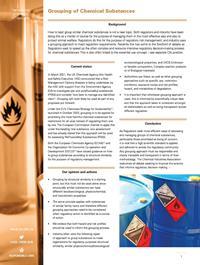Regulators do this for the purpose of regulatory risk management, and industry uses a grouping approach to meet regulation requirements. Recently this has come to the forefront of debate as Regulators seek to speed up the often complex and resource intensive regulatory decision-making process for chemical substances. This is also often linked to the essential use concept – see separate CIA position.
Current status
In March 2021, the UK Chemicals Agency (the Health and Safety Executive, HSE) announced that a Risk Management Options Analysis is being undertaken by the HSE with support from the Environment Agency (EA) to investigate per- and polyfluoroalkyl substances (PFAS) and consider how best to manage any identified risks. Grouping will most likely be used as part of any proposals put forward.
Under the EU’s Chemicals Strategy for Sustainability, launched in October 2020, grouping is to be applied for prioritising the most harmful chemical substances for restrictions for all uses instead of regulating them one by one. The European Commission intends to apply this under the heading ‘one substance, one assessment’ and has already stated that this approach will be used for assessing PerFluoroAlkyl Substances (PFAS).
Both the European Chemicals Agency (ECHA) and the Organization for Economic Co-operation and Development (OECD)[4] have issued guidance on how to group substances according to structural similarity for the purpose of regulatory management.
Our opinion and actions
- Grouping by structural similarity is a starting point, but this must not be used alone since structurally similar substances can have different (eco)toxicological, physicochemical, and toxicokinetic properties.
- The same principle applies with substances of similar family name and therefore different grouping approaches need to be considered when regulatory action is identified as a course of action.
- We believe that both hazard and risk profiles should be used to inform the grouping process.
- Industry often uses the following types of approach to group substances to make registrations for regulatory purposes structural similarity, similar physicochemical/toxicological/ecotoxicological properties, and UVCB (Unknown or Variable composition, Complex reaction products or of Biological materials).
- Authorities use these, as well as other grouping approaches such as specific use, restriction conditions, exposure routes and risk profiles, hazard, and metabolites of degradation.
- It is important that whichever grouping approach is used, this is informed by scientifically robust data and that the approach taken is consistent amongst all stakeholders as well as being transparent across different regulation.
Conclusion
As Regulators seek more efficient ways of assessing and managing groups of chemical substances, particularly those prioritised as being of concern, it is vital that a high scientific standard is applied and adhered to across the regulatory community. Any grouping approach must be responsible and clearly traceable and transparent in terms of their methodology. The Chemical Industries Association welcomes all debate seeking to improve the science that informs regulatory decision making.

Grouping of chemical Substances
How to best group similar chemical substances is not a new topic. Both regulators and industry have been doing this as a matter of course for the purpose of managing them in the most effective way and also to protect animal welfare.
DOWNLOADPDF | 827 Kb






















